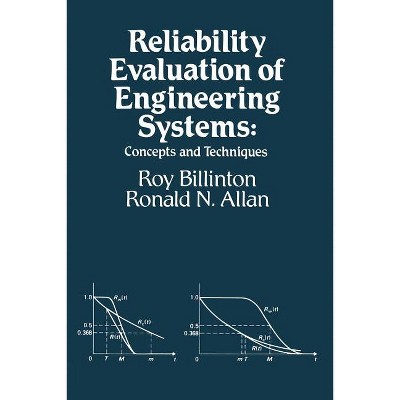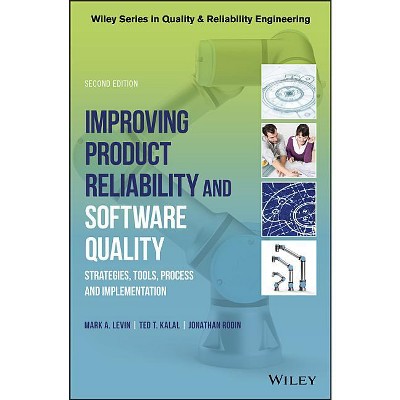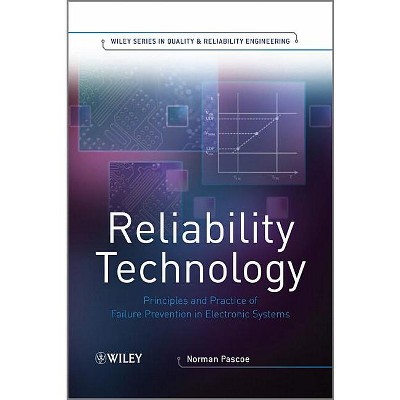Introduction to Reliability Engineering - 3rd Edition by James E Breneman & Chittaranjan Sahay & Elmer E Lewis (Hardcover)

About this item
Highlights
- Introduction to Reliability Engineering A complete revision of the classic text on reliability engineering, written by an expanded author team with increased industry perspective Introduction to Reliability Engineering provides a thorough and well-balanced overview of the fundamental aspects of reliability engineering and describes the role of probability and statistical analysis in predicting and evaluating reliability in a range of engineering applications.
- About the Author: James E. Breneman established and headed the Engineering Technical University at Pratt and Whitney, which provided more than 450,000 hours of instruction to employees during his tenure.
- 640 Pages
- Technology, Mechanical
Description
About the Book
"The object of this text is to provide an elementary and reasonably self-contained overview of reliability engineering that is suitable for an upper level undergraduate or first year graduate course for students of any engineering discipline. In addition, the third edition has added material for the "beginning" Reliability Engineer who is in the field and transferred to the Reliability/Safety discipline. The materials reflect the inherently interdisciplinary character of reliability considerations and the central role played by probability and statistical analysis in presenting reliability principles and practices. The examples and exercises are drawn from a variety of engineering and some non-engineering fields. They can be understood, however, with only the knowledge from the physics, chemistry, and basic engineering courses contained in the first years of nearly all engineering curricula. Likewise, the reader is presumed to have completed only the standard mathematics sequence, through ordinary differential equations, required of most engineering students. No prior knowledge of probability or statistics is assumed; the development of the required concepts is contained within the text. For each appropriate example in this edition, the necessary steps for obtaining a solution are indicated using readily available software. EXCEL is augmented in many cases with the MINITABª+. These two programs were chosen because they are widely available, and instructions for their use are also widely available. There are other Statistical software packages other than MINITAB that can do most of the analyses (SAS, SAS/JMP, RELIASOFT++, SUPERSMITH, and others) that are referenced in the 3rd edition. The problems and solutions are amenable to all these software packages as well as others"--Book Synopsis
Introduction to Reliability EngineeringA complete revision of the classic text on reliability engineering, written by an expanded author team with increased industry perspective
Introduction to Reliability Engineering provides a thorough and well-balanced overview of the fundamental aspects of reliability engineering and describes the role of probability and statistical analysis in predicting and evaluating reliability in a range of engineering applications. Covering both foundational theory and real-world practice, this classic textbook helps students of any engineering discipline understand key probability concepts, random variables and their use in reliability, Weibull analysis, system safety analysis, reliability and environmental stress testing, redundancy, failure interactions, and more.
Extensively revised to meet the needs of today's students, the Third Edition fully reflects current industrial practices and provides a wealth of new examples and problems that now require the use of statistical software for both simulation and analysis of data. A brand-new chapter examines Failure Modes and Effects Analysis (FMEA) and the Reliability Testing chapter has been greatly expanded, while new and expanded sections cover topics such as applied probability, probability plotting with software, the Monte Carlo simulation, and reliability and safety risk. Throughout the text, increased emphasis is placed on the Weibull distribution and its use in reliability engineering. Presenting students with an interdisciplinary perspective on reliability engineering, this textbook:
- Presents a clear and accessible introduction to reliability engineering that assumes no prior background knowledge of statistics and probability
- Teaches students how to solve problems involving reliability data analysis using software including Minitab and Excel
- Features new and updated examples, exercises, and problems sets drawn from a variety of engineering fields
- Includes several useful appendices, worked examples, answers to selected exercises, and a companion website
Introduction to Reliability Engineering, Third Edition remains the perfect textbook for both advanced undergraduate and graduate students in all areas of engineering and manufacturing technology.
From the Back Cover
A complete revision of the classic text on reliability engineering, written by an expanded author team with increased industry perspective
Introduction to Reliability Engineering provides a thorough and well-balanced overview of the fundamental aspects of reliability engineering and describes the role of probability and statistical analysis in predicting and evaluating reliability in a range of engineering applications. Covering both foundational theory and real-world practice, this classic textbook helps students of any engineering discipline understand key probability concepts, random variables and their use in reliability, Weibull analysis, system safety analysis, reliability and environmental stress testing, redundancy, failure interactions, and more.
Extensively revised to meet the needs of today's students, the Third Edition fully reflects current industrial practices and provides a wealth of new examples and problems that now require the use of statistical software for both simulation and analysis of data. A brand-new chapter examines Failure Modes and Effects Analysis (FMEA) and the Reliability Testing chapter has been greatly expanded, while new and expanded sections cover topics such as applied probability, probability plotting with software, the Monte Carlo simulation, and reliability and safety risk. Throughout the text, increased emphasis is placed on the Weibull distribution and its use in reliability engineering. Presenting students with an interdisciplinary perspective on reliability engineering, this textbook:
- Presents a clear and accessible introduction to reliability engineering that assumes no prior background knowledge of statistics and probability
- Teaches students how to solve problems involving reliability data analysis using software including Minitab and Excel
- Features new and updated examples, exercises, and problems sets drawn from a variety of engineering fields
- Includes several useful appendices, worked examples, answers to selected exercises, and a companion website
Introduction to Reliability Engineering, Third Edition remains the perfect textbook for both advanced undergraduate and graduate students in all areas of engineering and manufacturing technology.
About the Author
James E. Breneman established and headed the Engineering Technical University at Pratt and Whitney, which provided more than 450,000 hours of instruction to employees during his tenure. Now retired, Breneman has taught many public course offerings for the ASQ Reliability & Risk Division. In 2018 he was awarded the Eugene L. Grant Medal for outstanding leadership in educational programs in quality.
Chittaranjan Sahay holds the Vernon D. Roosa Distinguished Professor Chair in Manufacturing and Professorship in Mechanical Engineering at the University of Hartford, where he has held various offices including Associate Dean and Director of the Graduate Programs of the College of Engineering, Technology, and Architecture, and Chairman of the Mechanical Engineering Department.
Elmer E. Lewis is Professor of Mechanical Engineering at Northwestern University's McCormick School of Engineering and Applied Science. He has held appointments as Visiting Professor at the University of Stuttgart and as Guest Scientist at the Nuclear Research Center at Karlsruhe, Germany. He has been a frequent consultant to Argonne and Los Alamos National Laboratories as well as a number of industrial firms.
Shipping details
Return details
Trending Non-Fiction











